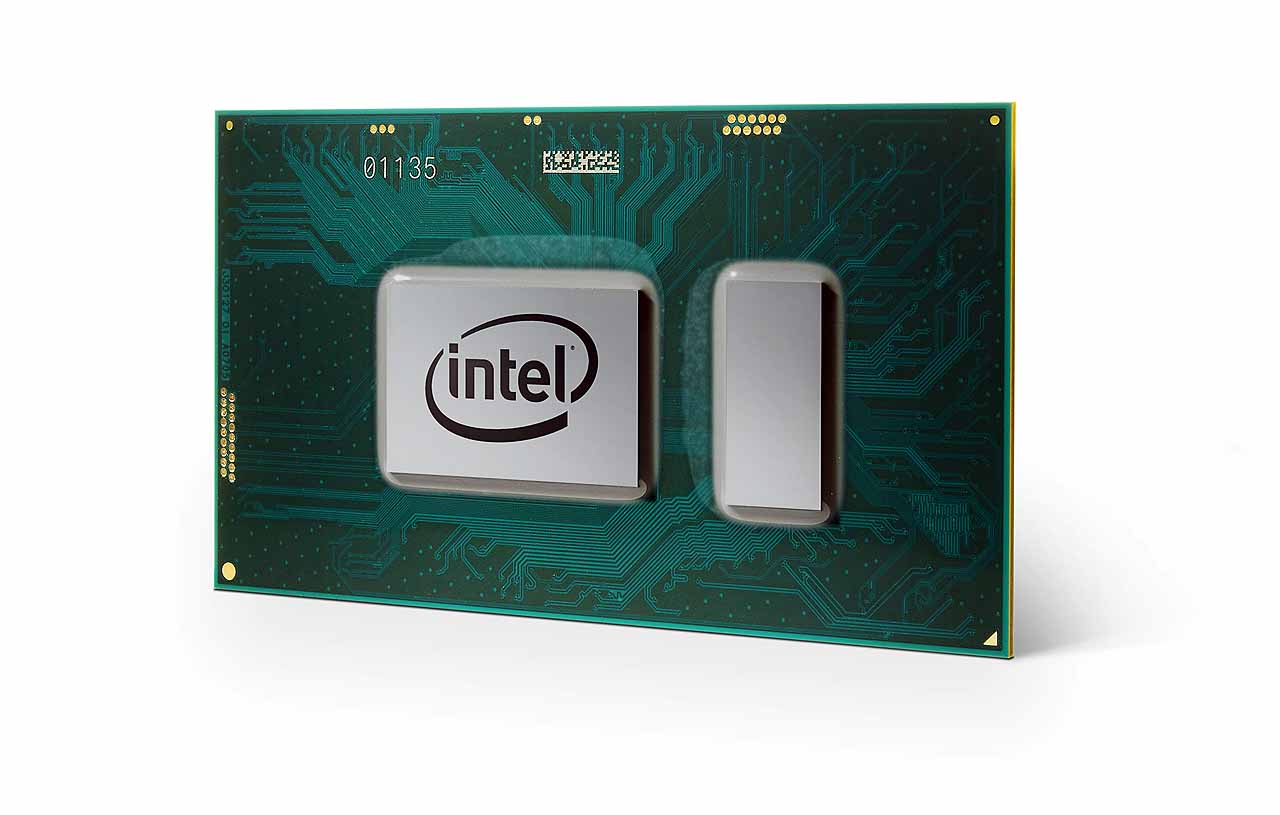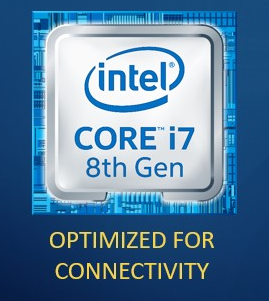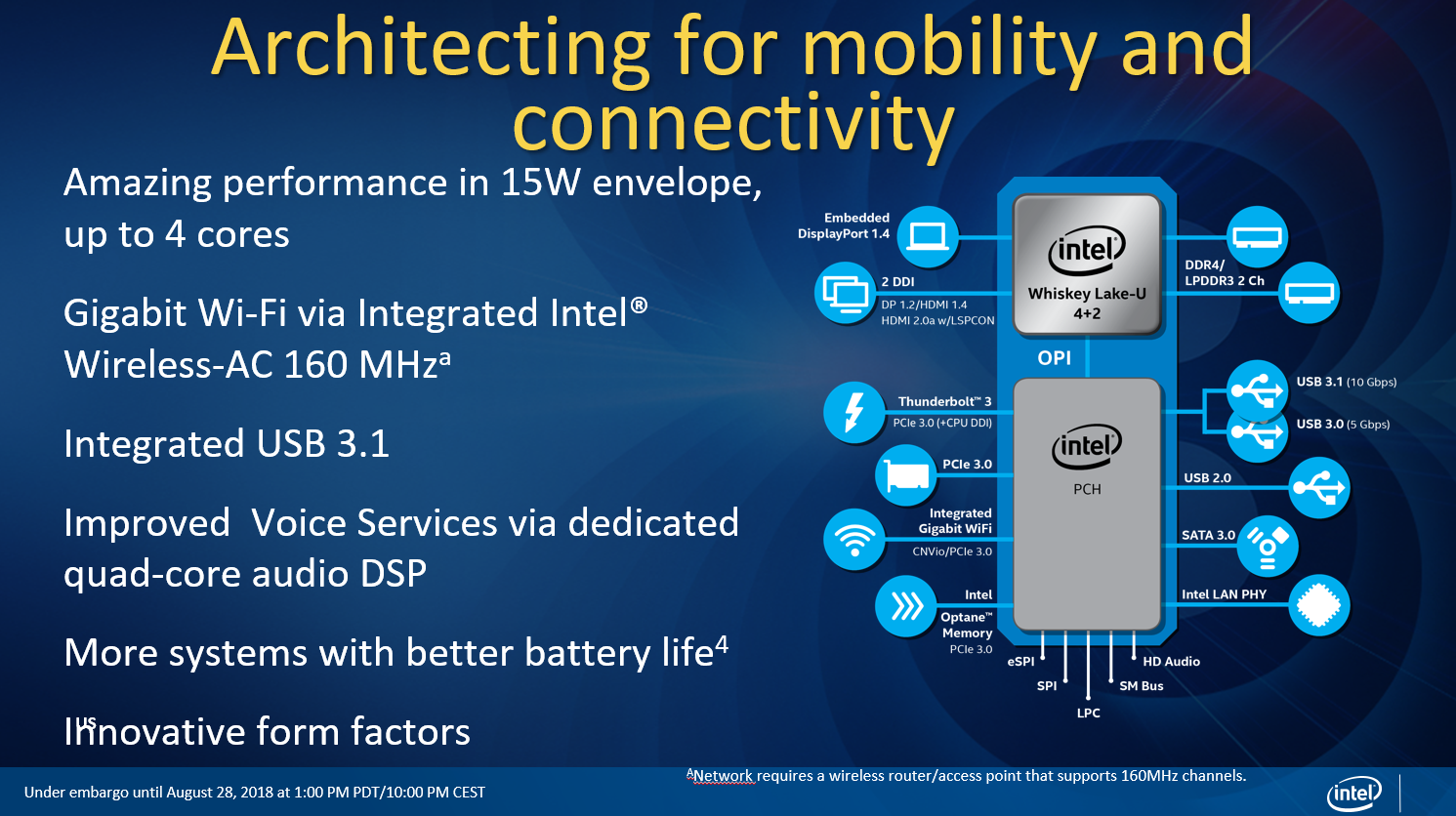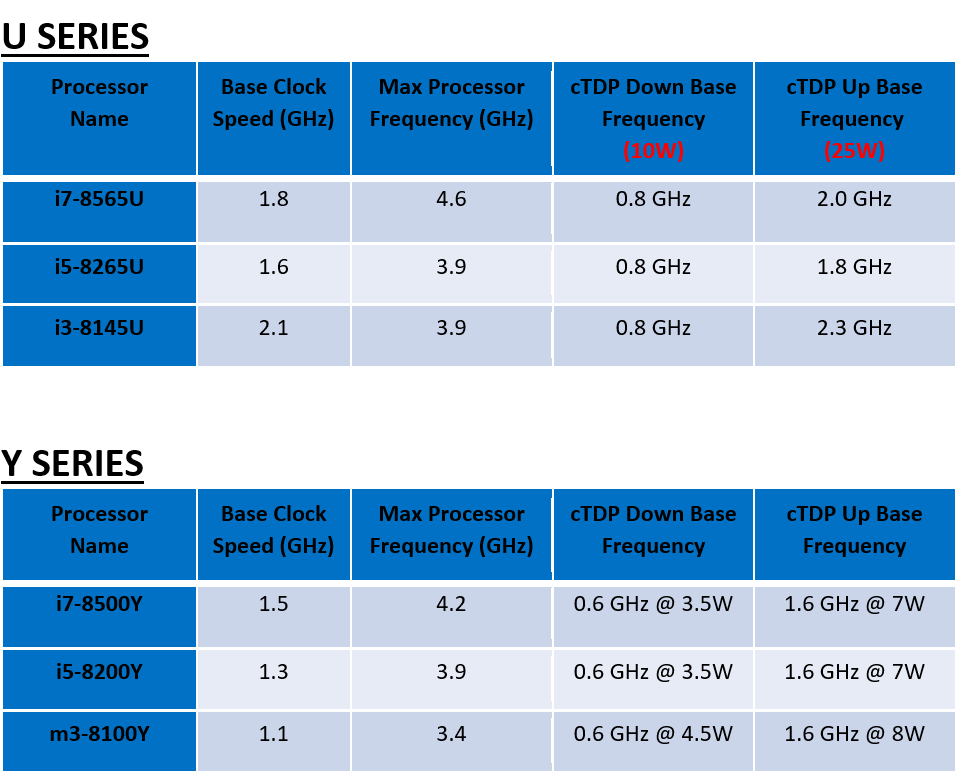Intel Launches Whiskey Lake and Amber Lake CPUs for Laptops
UPDATE 8/29: Intel has informed us that the Whiskey Lake processors also feature new in-silicon fixes for the Meltdown and L1TF vulnerabilities. Read more here.
Intel is rolling out six new processors in the new Whiskey Lake U-series and Amber Lake Y-series. These new processors come with new connectivity features, like support for Gigabit Wi-Fi and improved audio DSPs, and will debut in new laptops, 2-in-1s, and thin-and-light devices in the fall.
Intel's Kaby Lake-Refresh U-series models landed last year with the surprising addition of twice as many cores within the same power envelope. Intel also announced that it would include three different process nodes within the same eighth generation of processors, a first, which included the Kaby Lake-R, Coffee Lake, and Canon Lake processors.
Intel's delayed 10nm process has slowed progress on the smaller Cannon Lake processors, so the company developed the 14nm++ Whiskey Lake and 14nm+ Amber Lake processors to fill the gap between generations. The new Whiskey Lake models slot into the same eighth-gen Kaby Lake-R product stack, but that could lead to some confusion for less-savvy customers. Intel says it will roll out new "Optimized for Connectivity" branding for the new processors, but newer models will still be hard to identify.
The Amber Lake models replace the seventh-gen Y-series models. The Whiskey Lake and Amber Lake processors all feature the same underlying Kaby Lake microarchitecture as the previous-gen models, albeit with a few optimizations.
Whiskey Lake 15W U-Series Processors
Intel designed the 15W U-series processors for mainstream laptops and 2-in-1s.
| U-Series Processor | Architecture | Cores / Threads | Base / Boost Freq. (GHz) | TDP | L3 Cache (MB) | GPU | Memory Support (MHz) | Price |
|---|---|---|---|---|---|---|---|---|
| i7-8565U | Whiskey Lake | 4 / 8 | 1.8 / 4.6 | 15W | 8 | UHD 620 | DDR4-2400 / LPDDR3-2133 | $409 |
| i5-8265U | Whiskey Lake | 4 / 8 | 1.6 / 3.9 | 15W | 6 | UHD 620 | DDR4-2400 / LPDDR3-2133 | $297 |
| i3-8145U | Whiskey Lake | 2 / 4 | 2.1 / 3.9 | 15W | 4 | UHD 620 | DDR4-2400 / LPDDR3-2133 | $281 |
| i7-8650U | Kaby Lake-R | 4 / 8 | 1.9 / 4.2 | 15W | 8 | UHD 620 | DDR4-2400 / LPDDR3-2133 | Row 3 - Cell 8 |
| i7-8550U | Kaby Lake-R | 4 / 8 | 1.8 / 4.0 | 15W | 8 | UHD 620 | DDR4-2400 / LPDDR3-2133 | Row 4 - Cell 8 |
| i5-8350U | Kaby Lake-R | 4 / 8 | 1.7 / 3.6 | 15W | 6 | UHD 620 | DDR4-2400 / LPDDR3-2133 | Row 5 - Cell 8 |
| i5-8250U | Kaby Lake-R | 4 / 8 | 1.6 / 3.4 | 15W | 6 | UHD 620 | DDR4-2400 / LPDDR3-2133 | Row 6 - Cell 8 |
| i3-8130U | Kaby Lake | 2 /4 | 2.2 / 3.4 | 15W | 4 | UHD 620 | DDR4-2400 / LPDDR3-2133 | Row 7 - Cell 8 |
Intel hasn't been very forthcoming with specifications. The company omitted basic specifications for the graphics engine (the number of execution units and frequencies) in the press deck. Intel also stopped sharing multi-core CPU boost specifications, presumably because boost frequencies aren't guaranteed.
Get Tom's Hardware's best news and in-depth reviews, straight to your inbox.
We do know that that the Whiskey Lake Core i7 and i5 models come with the same basic four-core eight-thread design as the Kaby Lake-R models, but achieve much higher single-core boost frequencies. The Core i7 model tops out at an impressive 4.6 GHz, a marked improvement over the previous-gen's 4.2 GHz maximum. The i5 and i3 models top out at 3.9 GHz, which is an improvement of 300 and 500 MHz, respectively.
Provided the laptop's cooling solution is sufficient, these higher boost frequencies will provide snappier performance in common desktop tasks, like web browsers and light office applications. Intel maintains the same 15W TDP envelope, but it is important to remember that the company measures that specification at the base frequency. Higher boost frequencies could consume more power, but do not impact the TDP rating.
The Whiskey Lake i7 and i5 processors offer similar base frequencies, but the i3 models step back 100 MHz. The processors also come with the same amount of L3 cache and support dual-channel DDR4-2400/LPDDR3-2133.
Many of Intel's improvements come on the chipset front, which enables greater connectivity options. These additions generally mirror some of the improvements the company made with its latest 300-series chipsets for the desktop. The Whiskey Lake-U processors connect to the platform controller hub (PCH) through the on-package interface (OPI - 4GT/s).
Intel doubled Wi-Fi capabilities with support for Wireless-AC 2x2 160 MHz. Intel integrated the MAC into the chipset, but it still requires a separate CRF module for operation. Intel offers its own Jefferson Peak 2 AC-9560 CNVi module as the other half of the integrated solution, but the company also supports third-party solutions. This speedy connection, which debuted with the Gemini Lake processors, provides more bandwidth than a wired connection with up to 1,733 Mbps, but it requires a router that supports the feature.
The chipset now has native support for USB Gen 3.1. Some devices also support LTE connectivity, but that is not an integrated feature of the chipset. Intel also lists Thunderbolt 3 (TB3) on its chipset diagram, but that is somewhat misleading because TB3 still requires a discrete controller chip.
The chipset supports Wake-On-Voice and enhanced voice recognition for Alexa and Cortana, along with other voice-activated personal assistants. The new audio DSP supports using up to five independent voice-activated applications simultaneously while the PC is in a low power state.
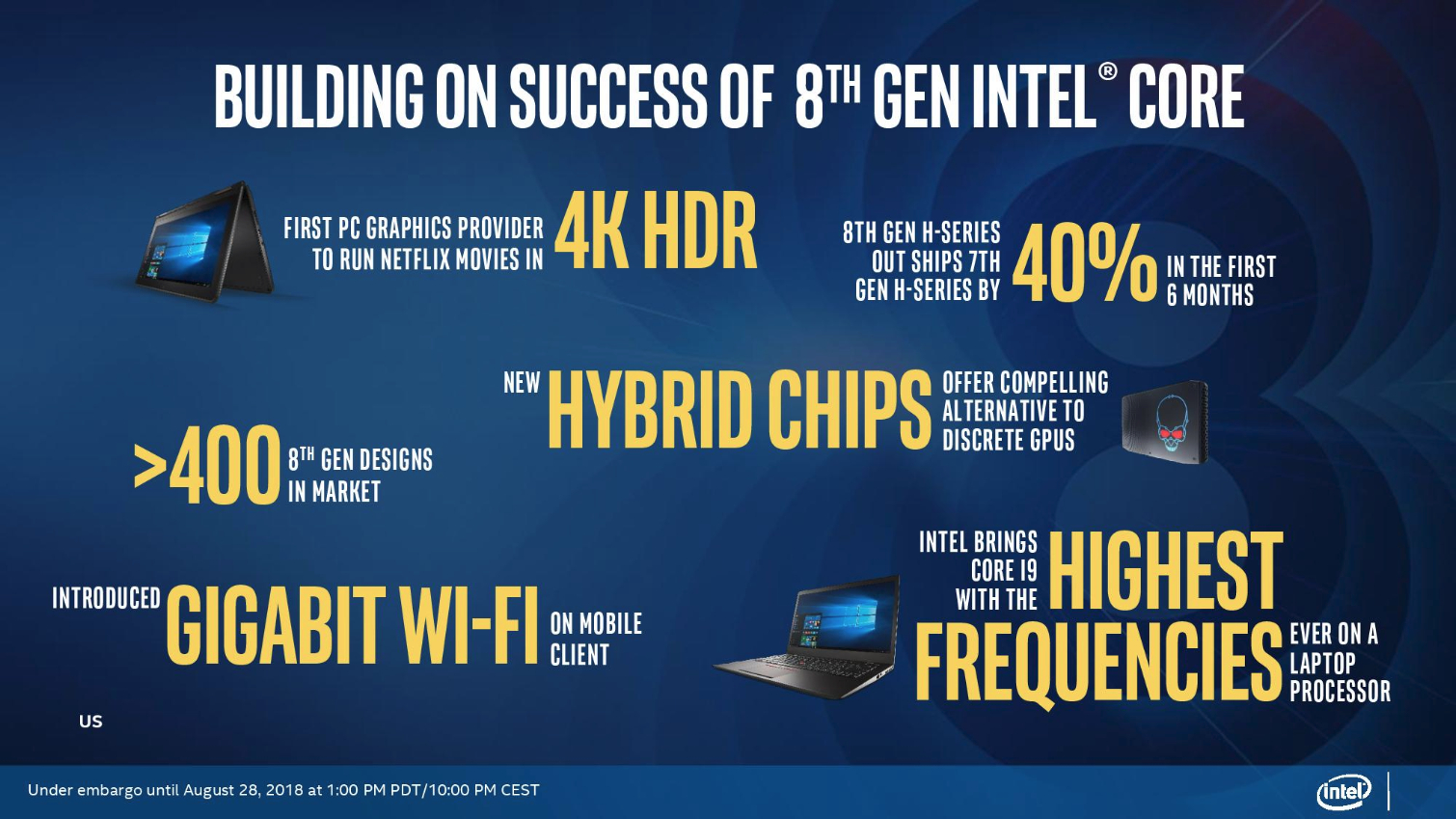



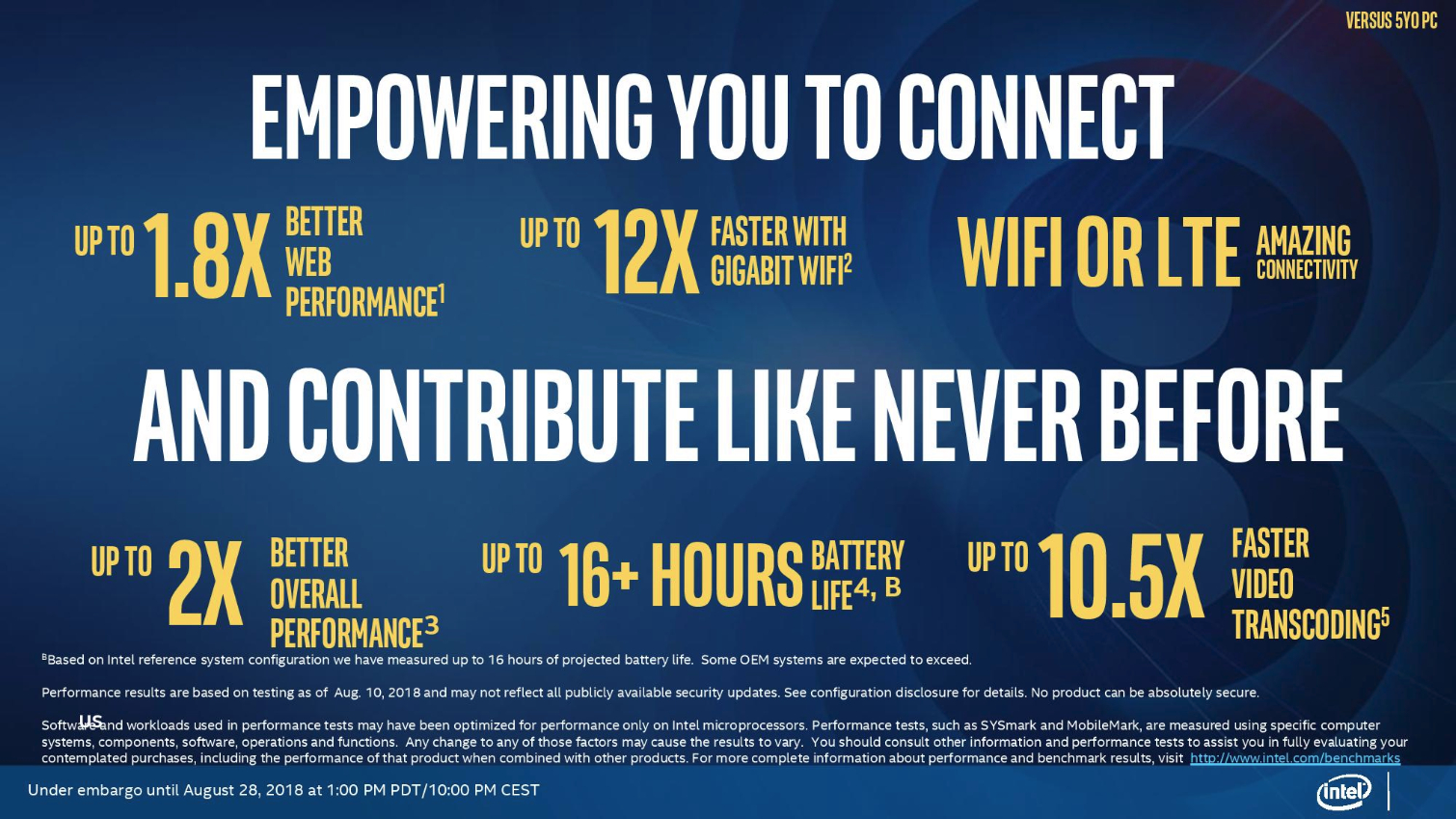
Intel also provided internal performance data comparing the new processors with older five-year-old systems. As per its new policy, Intel's results represent the impact of the Spectre/Meltdown patches. We know that older processors suffer from a much larger performance hit from the patches, so while these results represent actual post-patch performance, Intel likely gains a small bump in several of the benchmarks that compare to older systems.
Intel claims up to 1.8X better web browser performance and 12X faster Wi-Fi with the Gigabit connection. Other claims include twice the overall performance, up to 16 hours of battery life, and 10.5X faster video transcoding. As with all vendor provided specifications, take these numbers with a grain of salt.
Intel also caters to the gaming crowd with its new gamplay.intel.com website. This site automatically detects and optimizes Intel's integrated graphics for various game titles. It also hosts the latest driver downloads.
Amber Lake 5W Y-Series Processors
Intel designed the low-power Amber Lake processors for fanless thin-and-light devices.
| Processor | Architecture | Cores / Threads | Base / Boost Freq. (GHz) | TDP | L3 Cache (MB) | Graphics | Memory Support (MHz) | Price |
|---|---|---|---|---|---|---|---|---|
| i7-8500Y | Amber Lake | 2 / 4 | 1.5 / 4.2 | 5W | 4 | UHD Graphics 615 | LPDDR3-1866 | $393 |
| i5-8200Y | Amber Lake | 2 / 4 | 1.3 / 3.9 | 5W | 4 | UHD Graphics 615 | LPDDR3-1866 | $291 |
| m3-8100Y | Amber Lake | 2 / 4 | 1.1 / 3.4 | 5W | 4 | UHD Graphics 615 | LPDDR3-1866 | $281 |
| i7-7Y75 | Kaby Lake | 2 / 4 | 1.3 / 3.6 | 4.5W | 4 | HD Graphics 615 | DDR3L-1600, LPDDR3-1866 | Row 3 - Cell 8 |
| i5-7Y57 | Kaby Lake | 2 / 4 | 1.2 / 3.3 | 4.5W | 4 | HD Graphics 615 | DDR3L-1600, LPDDR3-1866 | Row 4 - Cell 8 |
| i5-7Y54 | Kaby Lake | 2 / 4 | 1.2 / 3.2 | 4.5W | 4 | HD Graphics 615 | DDR3L-1600, LPDDR3-1866 | Row 5 - Cell 8 |
| m3-7Y32 | Kaby Lake | 2 / 4 | 1.1 / 3 | 4.5W | 4 | HD Graphics 615 | DDR3L-1600, LPDDR3-1866 | Row 6 - Cell 8 |
| m3-7Y30 | Kaby Lake | 2 / 4 | 1 / 2.6 | 4.5W | 4 | HD Graphics 615 | DDR3L-1600, LPDDR3-1866 | Row 7 - Cell 8 |
The Y-Series also features the same dual-core Hyper-Threaded design as the Kaby Lake models, but the 8th-gen models provide much higher single-core boost frequencies. The i7 and i5 models step forward 600 MHz, while the m3 model offers 400 MHz of additional clock speed. The processors also have a slightly higher (0.5W) TDP rating. The Y-Series processors share the same Wireless-AC that supports Gigabit wireless speeds, along with support for Modern Standby, eSIMs, and Gigabit LTE modems. Intel also says that is has improved touch and stylus interactions but hasn't provided further details.
Configurable TDPs
All U-Series and Y-series products feature a configurable TDP (cTDP) range. This allows OEMs to tailor mobile products with lower TDP (cTDP-down) settings for increased battery life, or higher settings (cTDP-up) that trade battery life for more performance.
The lower cTDP-down settings allow vendors to cram powerful processors into thinner and lighter devices by easing the thermal dissipation requirements. Unfortunately, this permanent setting lowers performance significantly, and the vendor is not required to disclose the TDP configuration. Many do this with little fanfare. The end user cannot adjust the statically-assigned TDP value, but some devices use a dynamic cTDP implementation that adjusts based on several parameters, such as skin and processor temperature.

Paul Alcorn is the Editor-in-Chief for Tom's Hardware US. He also writes news and reviews on CPUs, storage, and enterprise hardware.
-
mereguyfawkes Highest performance in a laptop? More like hardest throttling in a laptop.Reply
Dat i9 Macbook tho. -
mihen Intel must be in trouble if they gave one of their processors an awesome name like Whiskey Lake. That's the kind of thing you do when you are behind like Piledriver.Reply -
SirStephenH "Intel offers its own Jefferson Peak 2 AC-9560 CNVi module as the other half of the integrated solution, but the company also supports third-party solutions. This speedy connection, which debuted with the Gemini Lake processors, provides more bandwidth than a wired connection with up to 1,733 Mbps, but it requires a router that supports the feature."Reply
But because, unlike with ethernet, the spectrum is shared by every single device on your network and even those on other people's networks, you won't actually be seeing gigabit speeds. Gigabit ethernet is still faster, even though 160MHz WiFi-AC technically has more bandwidth under the best of conditions. -
wownwow "Foreshadow" inside, with the mitigations that only reduce but can't eliminate the risk?Reply
Intel, all system companies and retail stores selling the “known” faulty products with the “known” INTENDED flaws (of not following the specs) inside the products should be sued for the crime of the fraud in criminal courts, shouldn’t they?
Sue the system companies to have them at least put the warning sticker "This product has known security risks with Intel CPU inside." on the products using the Intel CPUs that have the issues! -
Paul Alcorn Reply21276255 said:"Foreshadow" inside, with the mitigations that only reduce but can't eliminate the risk?
Intel, all system companies and retail stores selling the “known” faulty products with the “known” INTENDED flaws (of not following the specs) inside the products should be sued for the crime of the fraud in criminal courts, shouldn’t they?
Sue the system companies to have them at least put the warning sticker "This product has known security risks with Intel CPU inside." on the products using the Intel CPUs that have the issues!
We actually just learned that Whiskey Lake does have some mitigations built into the hardware. learn more here --
https://www.tomshardware.com/news/whiskey-lake-mitigations-in-silicon-intel,37723.html
